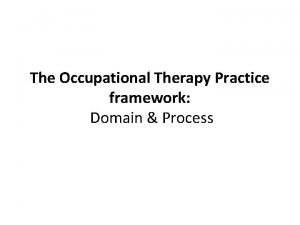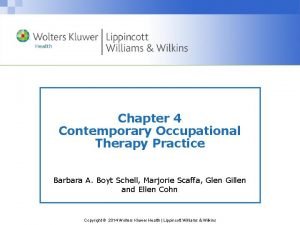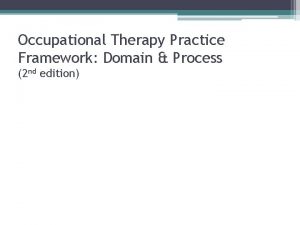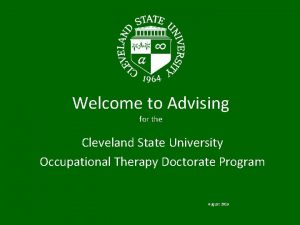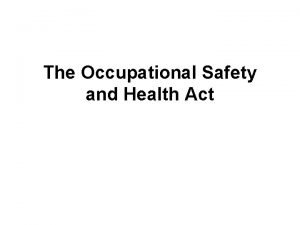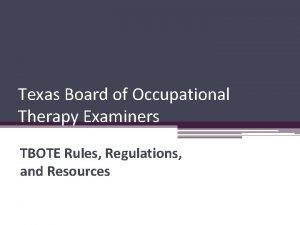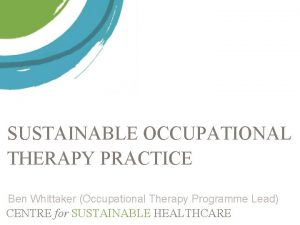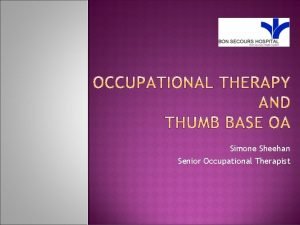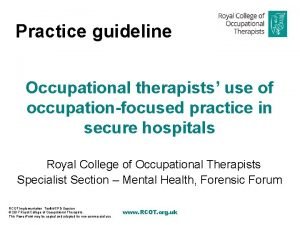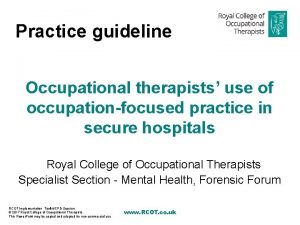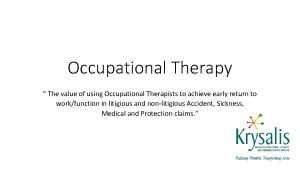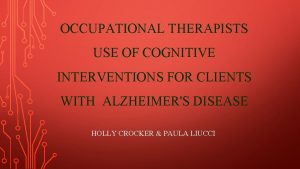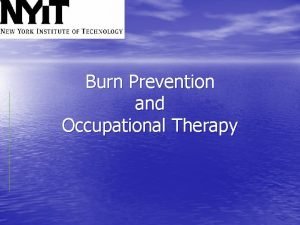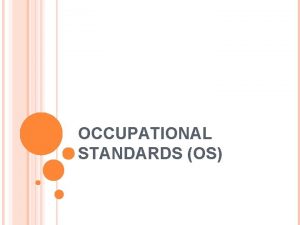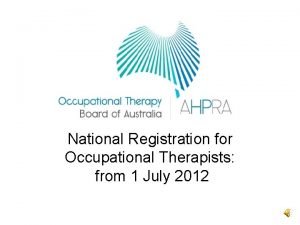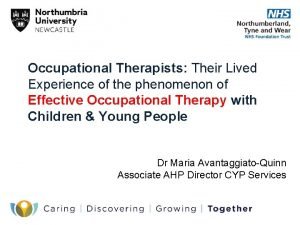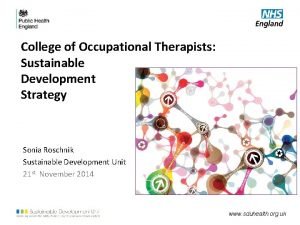Occupational therapists use of occupationfocused practice in secure



















- Slides: 19

Occupational therapists’ use of occupation-focused practice in secure hospitals Practice guideline College of Occupational Therapists Specialist Section – Mental Health, Forensic Forum COT Implementation Toolkit/CPD Session © 2015 College of Occupational Therapists. This Power. Point may be copied and adapted for non-commercial use www. COT. org. uk

Learning outcomes • To explore aspects of the practice guideline recommendations in relation to current practice. • To develop an understanding of the importance of using practice guidelines to inform practice. • To explore and develop an understanding of how to use the COT Audit Form for use with the evidence-based recommendations. COT Implementation Toolkit/CPD Session © 2015 College of Occupational Therapists www. COT. org. uk 2

Practice question: What evidence is there to support the use of occupation in occupational therapy in secure hospitals with patients over the age of 18? COT Implementation Toolkit/CPD Session © 2015 College of Occupational Therapists www. COT. org. uk 3

Key objective of guideline To provide specific recommendations to support the use of occupation-focused occupational therapy in secure hospitals. The guideline is relevant to high, medium and secure hospitals. COT Implementation Toolkit/CPD Session © 2015 College of Occupational Therapists www. COT. org. uk 4

Methodology 2. Guideline scope defined involving stakeholders 1. Guideline development group established 4. Screen findings 5. Critically appraise articles 6. Development of practice guideline recommendations 9. Published by COT 2012 COT Implementation Toolkit/CPD Session © 2015 College of Occupational Therapists 3. Literature search 7. Peer review, stakeholder and service user consultation 8. Final draft approved by COT Practice Publications Group www. COT. org. uk 5

Evidence-based recommendations Recommendations are based on the evidence available within 34 critically appraised papers. Each recommendation is assigned: • A strength scoring 1 or 2 (Strong or Conditional) • A quality grading A, B, C or D (High, Moderate, Low or Very Low) COT Implementation Toolkit/CPD Session © 2015 College of Occupational Therapists www. COT. org. uk 6

Recommendation areas Model of Human Occupation Framework: • • Volition Habituation Performance capacity Environmental considerations COT Implementation Toolkit/CPD Session © 2015 College of Occupational Therapists www. COT. org. uk 7

Volition 1. It is recommended that occupational therapists always take into account 1 C the gender specific needs of patients with whom they are working. (Baker and Mc. Kay 2001, C) 2. It is recommended that occupational therapists consider the occupational life history of patients, including that at the time of the index offence, and its influences on occupational performance, life satisfaction and criminogenic lifestyle. (Lindstedt et al 2005, B) 1 B 3. It is recommended that occupational therapists establish as part of their 1 B assessment, patients’ perspectives of their occupational performance and social participation, and work with those perceptions in planning care. (Lindstedt et al 2004, B) COT Implementation Toolkit/CPD Session © 2015 College of Occupational Therapists www. COT. org. uk 8

Volition contd. Volition 4. It is recommended that occupational therapists work collaboratively with patients in identifying and planning their care pathways. (Clarke 2002, C) 1 C 5. It is recommended that occupational therapists recognise the specific intrinsic value of occupation to individual patients. (Craik et al 2010, C) 1 C 6. It is recommended that occupational therapists facilitate meaningful occupational choices for patients. (Craik et al 2010, C; Cronin-Davies 2010, C; Mason and Adler 2012, C; Morris 2012, C; O’Connell et al 2010, D; Stewart and Craik 2007, C) 1 C 7. It is recommended that occupational therapists ascertain patients’ aspirations towards paid employment at the earliest opportunity, and during rehabilitation. (Mc. Queen 2011, C) 1 C COT Implementation Toolkit/CPD Session © 2015 College of Occupational Therapists www. COT. org. uk 9

Habituation 8. It is recommended that occupational therapists consider the patients’ roles, (past, present and future) within treatment planning and interventions. (Schindler 2005, C) 1 C 9. It is recommended that occupational therapy facilitates a range of interventions that enable patients to engage in structured and constructive use of time throughout the week, including weekends and evenings. (Bacon et al 2012, D; Castro et al 2002, C; Farnworth et al 2004, C; Jacques et al 2010, D; Stewart and Craik 2007, C) 1 C COT Implementation Toolkit/CPD Session © 2015 College of Occupational Therapists www. COT. org. uk 10

Performance capacity 10. It is recommended that occupational therapists routinely used standardised outcome measures to assess and demonstrate patients’ progress. (Green et al 2011, C; Clarke 2003, D; Fitzgerald 2001, C; Mc. Queen 2001, C) 1 C 11. It is recommended that occupational therapists consider supported employment or prevocational training as part of occupation-based intervention opportunities for patients. (Garner 1995, D; Mc. Queen 2011, C; Smith et al 2010, D) 1 C 12. It is recommended that occupational therapists consider the use of healthy living programmes and exercise as activity to benefit health and wellbeing. (Bacon et al 2012, D; Mc. Queen 2011, C; Prebble et al 2011, D; Tetlie et al 2008, C; Tetlie et al 2009, C; Teychenne et al 2010, C) 1 C 13. It is suggested that occupational therapists include social inclusion programmes as part of their intervention to improve occupational functioning. (Fitzgerald 2011, C) 2 C COT Implementation Toolkit/CPD Session © 2015 College of Occupational Therapists www. COT. org. uk 11

Environmental considerations 14. It is recommended that occupational therapists fully value therapeutic use of self as being integral to the positive engagement of patients in occupations. (Mason and Adler 2012, C; Tetlie et al 2009, C) 1 C 15. It is recommended that occupational therapists ensure that risk assessment is a dynamic process, in which judgements are made on an on-going basis in collaboration with patients and members of the multidisciplinary team. (Cordingley and Ryan 2009, B) 1 C 16. It is suggested that occupational therapists recognise the role and contribution of carers in the recovery of patients. (Absalom et al 2010, C; Fitzgerald et al 2012, D) 2 C 17. It is recommended that occupational therapists consider the impact of the environment on quality of life and occupational engagement. (Craik et al 2010, C; Fitzgerald et al 2011, D; Long et al 2008, C; Long et al 2011, C; Morris 2012, C) 1 C COT Implementation Toolkit/CPD Session © 2015 College of Occupational Therapists www. COT. org. uk 12

Environmental considerations contd. Environmental considerations 18. It is suggested that occupational therapists liaise with a range of community services to facilitate replication of patients’ pro-social behaviours developed during an inpatient stay. (Elbogen et al 2011, D; Lin et al 2009, C; Lindstedt et al 2011, C) 2 C 19. It is recommended that occupational therapists demonstrate their competencies (skills and training) to facilitate identified therapeutic groups, enhancing the confidence and participation of patients. (Mason and Adler 2012, C) 1 C 20. It is recommended that occupational therapists articulate, to patients and the multidisciplinary team, their role and the contribution of occupational therapy to the overall treatment performance. (Cronin-Davis 2010, C) 1 C COT Implementation Toolkit/CPD Session © 2015 College of Occupational Therapists www. COT. org. uk 13

Impact of practice guideline for you: the practitioner • Challenges / affirms your current practice. • Provides evidence-based recommendations to inform and support your practice. • Raises awareness of benefits and risks and organisational and financial barriers. • Provides a vehicle for you to audit and justify your practice COT Implementation Toolkit/CPD Session © 2015 College of Occupational Therapists www. COT. org. uk 14

Impact of practice guideline for managers • Provides evidence of the need for occupationfocused occupational therapy for adults in secure hospitals. • Provides a structure to audit the work of occupational therapists within the service to improve service quality. • Provides a vehicle for justifying service provision. COT Implementation Toolkit/CPD Session © 2015 College of Occupational Therapists www. COT. org. uk 15

Impact of practice guideline for commissioners • Articulates the need for occupational therapy interventions within secure hospital services. • Provides recommendations developed by a NICE Accredited process. • Can help educate commissioners to identify learning needs for the workforce. • Audit form provides a mechanism to review service delivery in accordance with the evidence. COT Implementation Toolkit/CPD Session © 2015 College of Occupational Therapists www. COT. org. uk 16

Impact of practice guideline for patients • The recommendations reinforce the fundamental importance of the patient perspective • In being adopted by services and occupational therapists, the guideline should improve the consistency and quality of intervention for users of services. • Gives assurance that practitioners use the available evidence to support interventions. COT Implementation Toolkit/CPD Session © 2015 College of Occupational Therapists www. COT. org. uk 17

Patient perspectives Any reduction in the occupational therapy programme was viewed by one patient as limiting opportunities for engagement in occupational therapy groups and learning new skills A preference for one-to-one occupational therapy sessions, with the importance of the occupational therapists in relation to motivation being highlighted, was also expressed by one patient in the context of group work The impact of the environment was reinforced by one patient, indicating that a homely environment was desired In relation to the availability of occupational opportunities, another patient reported that it was a struggle at weekends on the ward 18

Practice guideline resources • College of Occupational Therapists (2012) Occupational therapists’ use of occupation-focused practice in secure hospitals: practice guideline. London: COT. • Audit tool • Quick Reference Guide • Feedback form Resources are available from the College’s website at: http: //www. cot. co. uk/library-publications/cotpublications/practice-guidelines. COT Implementation Toolkit/CPD Session © 2015 College of Occupational Therapists www. COT. org. uk 19
 Royal college of occupational therapists
Royal college of occupational therapists Client centered therapists try to appreciate
Client centered therapists try to appreciate Which of the following therapists would most likely
Which of the following therapists would most likely Domains of occupational therapy
Domains of occupational therapy Contemporary occupational therapy practice
Contemporary occupational therapy practice What is occupational health
What is occupational health Practice assessor and practice supervisor
Practice assessor and practice supervisor A dance that shows imagery combat duel.
A dance that shows imagery combat duel. Occupational therapy cleveland state
Occupational therapy cleveland state The short child occupational profile
The short child occupational profile Peo framework occupational therapy
Peo framework occupational therapy Williams steiger act
Williams steiger act Alert program occupational therapy
Alert program occupational therapy Texas occupational therapy license
Texas occupational therapy license Backward chaining occupational therapy
Backward chaining occupational therapy Occupational therapy and environmental sustainability
Occupational therapy and environmental sustainability Definition of public administration
Definition of public administration Us social hierarchy
Us social hierarchy Bona fide occupational qualification
Bona fide occupational qualification Types of grips
Types of grips



